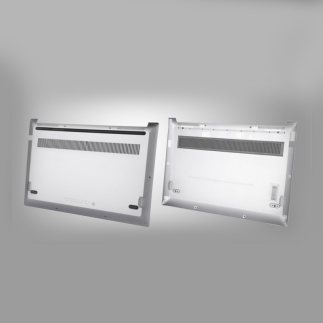|
Laptop Shell Forming ProcessLaptop Shell Forming Process Laptop materials include aluminum alloy, ABS engineering plastic, carbon fiber, etc. When manufacturers choose materials to manufacture laptops, they mostly consider cost - is the material itself expensive, and what are the molding processes and costs? But nowadays computers focus on appearance, so they prefer metal laptop shells.
Forming Process of Magnesium Aluminum Alloy Shell Currently, due to cost and process reasons, mainstream merchants rarely use magnesium aluminum alloy to manufacture the entire shell. Usually only used on the top cover (A-side) or palm rest (D-side) of a laptop. The general process flow is: stamping/die-casting into sheet metal → CNC treatment → surface treatment. Currently, the large-scale automated manufacturing of magnesium aluminum alloy shells has not been achieved on a large scale. Below are two small-scale commercial rapid prototyping methods. Among them, the integrated CNC machining technology for laptops has been applied by some domestic manufacturers to the C-side of their high-end products. Integrated CNC machining process: more precise, thinner, and stronger Apple's pioneering integrated CNC machining process - CNC cutting of entire pieces of metal to obtain precise and seamless shells. The aluminum plate is made of cylindrical solid aluminum die-casting, and after precision machining, it is first cut into an integrated body prototype. This process involves a total of nine CNC milling processes, ultimately obtaining a precise integrated shell called "Unibody". Applicable material: Aluminum alloy is the preferred choice for this process, and its excellent strength to weight ratio also meets the portability requirements of 3C products. Advantages: thinner, lighter, and stronger; The aesthetic quality after anodizing is also very stable; The potential quality issues are greatly reduced, which is very beneficial for quality control. Disadvantage: High requirements for machining accuracy and process, making it difficult to promote on a large scale. Currently, only a few manufacturers use it in their high-end series, including: One step stamping process: completing complex casings in one step This process adapts to the thermal expansion and contraction of the sheet and mold through complex calculations. After determining the variation between the concave mold and the convex mold, the concave mold is heated to 200 degrees Celsius, and the temperature is accurately controlled to obtain a delicate and complex shell, effectively avoiding the fracture of the convex mold. The punching material formed by this method does not need to reserve anti fracture angles, and can produce almost right angle products, which can be efficiently punching. Scope of application: Magnesium alloy Advantages: High production efficiency, high formability, stronger adaptability in the mold field, and can meet more market demands. Disadvantages: The calculation process is complex, requiring precise temperature control, and the cost of magnesium alloys is high. |






